The MONRE said land prices in some localities and areas have increased dramatically, which could affect socio-economic development and investment projects.
    |
 |
|
A corner of Long Bien District in Hanoi. In many localities, fake news about project planning and development has been spread. (Photo for illustration) |
The ministry assigned the General Department of Land Administration to inspect the planning, leasing and transferral of land in 26 localities. In Hanoi and Ho Chi Minh City, the department will inspect the land registration, the issuance of land-use rights certificates, changes of land-use purposes and land-use management in a number of projects which have been slow to put land into use.
The MoC also requested localities to publish information relating to planning, the progress of infrastructure development projects and real estate projects, especially big ones and their merger, establishment and upgrading of administrative units.
Earlier, Hanoi was asked to prevent land speculation when implementing the Red River urban planning after property prices in some areas of the city surged after reports on draft planning for the area were released in June.
Ha Long City in the northeastern province of Quang Ninh has reviewed the authentication of transactions relating to land-use rights, while Bac Giang province asked communal People’s Committees to pay attention to surging land prices.
Local authorities were also told to control virtual transactions while actively regulating land funds through the creation of a clean land fund for the auction of land-use rights.
Nguyen Van Dinh, General Secretary of the Vietnam Association of Realtors (VARs), said localities should inspect all land-use activities as well as transactions.
Dinh said localities need to manage those participating in listing and offering land for sale, as well as provide sufficient information on economic development policies and land-use planning to handle news reports that can impact land prices.
He added that the State should adjust the law towards digitising land and urban planning to help people conveniently look up real estate product information. At the same time, it is necessary to manage the property exchange floors and brokerage more closely and effectively.
In many localities, fake news about project planning and development has been spread. There were even cases of taking advantage of the directions of State leaders and creating fake documents to spread news. This has a very negative impact on the interests of investors who lack knowledge and experience, he said.
In addition, there were also cases offering land for sale not suitable with the law such as forest land, fields and gardens. Many brokers regularly gather in these areas, causing excitement, spreading unwarranted information, pushing prices up to entice investors.
He said part of the reason is low interest rates. The cash flow tends to invest in the real estate market, creating 'land fever' in many areas, despite the COVID-19 pandemic. In some localities, the land price frame was increased by 15 to 20 percent. The limited supply of housing projects, especially social housing, also contributed to make land demand higher. In addition, the demand for investment into land has surged as other sectors have not seen effectiveness due to the pandemic.
Land fever would reduce development resources in many sectors. It would prevent the call for investment into localities due to surging land prices, causing a hike in other costs.
At a Government press conference, State Bank of Vietnam Deputy Governor Dao Minh Tu said as of March 15, real estate loans of the banking sector increased by 2.13 percent, higher than credit growth of 2.04 percent for the economy in general.
For people and organisations that speculate on real estate, or invest in projects with low solvency or investment efficiency, the SBV always strictly controls and takes limited measures, according to the Deputy Governor.
Before the real estate situation showed hot signs, the central bank warned credit institutions. However, the increase of 2.13 percent was not in all credit institutions, but only a few.
Source: VNA